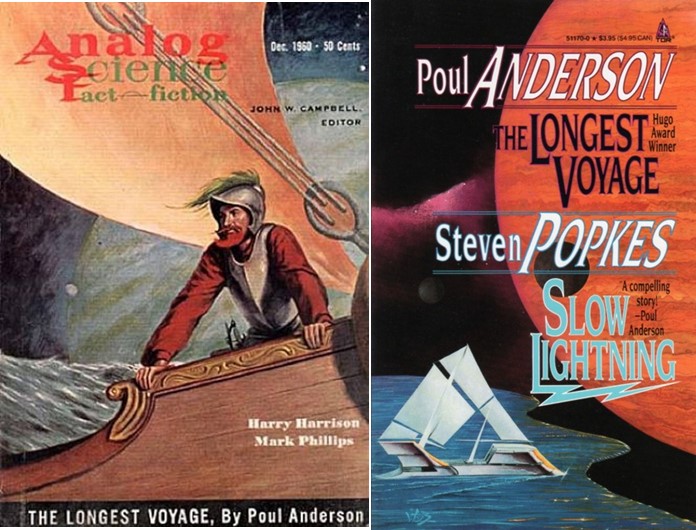Tor Doubles #30: Poul Anderson’s The Longest Voyage and Steven Popkes’ Slow Lightning

Tor Double #30 contains Poul Anderson’s third and final appearance and was originally published in February 1991. He is joined by Steve Popkes with a story original to this volume and which has not been reprinted.
“The Longest Voyage” was originally published in Analog in December 1960. It won the Hugo Award for Best Short Story, which makes it a strange choice for the Tor Doubles series, which generally published novellas, but the second story in the volume may be the longest story published in the series.
There are many science fiction stories that take historical characters and use them as the basis for a different take on the world. Robert J. Sawyer notably published his trilogy of novels Far-Seer, Fossil Hunter, and Foreigner whose characters were based on Galileo, Charles Darwin, and Sigmund Freud. In “The Longest Voyage,” Captain Rovic appears to be based on Ferdinand Magellan, leading the Golden Leaper (shades of Francis Drake’s Golden Hind) on a circumnavigation of the moon on which they live in search of the fables Aureate Cities.
The story opens with Rovic putting down a mutiny, and apparently not the first one aboard the ship. In order to give the reader the needed knowledge of his world, Anderson has the ship’s navigator, Froad, give the narrator, Zhean, a lesson in astronomy, making it clear that they are on a moon around the planet Tambur, which has multiple moons.
Once the background is out of the way, Anderson quickly focuses on the Golden Leaper’s arrival at a previously unknown to them archipelago, Hisagazi. There, they find a less advanced civilization and get to know them as they repair the Golden Leaper. In the process of learning their language, they also learn that the islanders claim that there is a god living on the mountain above the capital of Hisagazi. A visit to the island proves that the god, Val Nira, not only exists, but is a space traveler whose space ship became stranded in Hisagazi forty years earlier. The Hisagazins don’t have access to the mercury he needs to fix his spaceship, but he hopes Captain Rovic might be able to help him.
When writing science fiction, first contact stories are generally thought to be the discovery of a new race on a new planet by explorers, but Anderson turns that on his head with a first contact story between inhabitants of the same moon. The Hisagazi and Captain Rovic’s crew come from very different cultures, and, while Anderson glosses over Rovic’s gaining familiarity with the Hisagazi language, it is clearly a gradual endeavor, which also includes learning about their culture and befriending various Hisagazi, most notably Guzan and, through him, the Holy One, Iskilip. Although there is an apparent good will between the two cultures, there is an undercurrent of distrust and deception.
Using his deception to gain an audience with Val Nira, Rovic is able to learn what the god is, and what he wants. In doing so, Guzan learned of Rovic’s deception, which leads to a falling out between the two sides, with the possibility of a battle between the natives and the explorers and each begin to speculate on how the other side will make use of the technology Val Nira’s ship provides them with, for they also come to the realization that, not a god, Val Nira doesn’t have an indefinite lifespan. Val Nira, intent on returning to the society that he has lost and which seems to have abandoned him, makes the situation worse by telling stories of his life before landing on the moon, giving both sides visions of what they could gain with his technology.
Even before Rovic’s men meat Val Nira, they have a strong understanding of their cosmology, given the complexity of their planetary system. Froad’s lessons to Zhean early in the story provides a background, not only to Zhean, but to all the characters when they gain the additional pieces of knowledge from Val Nira, which fit in well with the cosmology they already understand, while filling in gaps and making it clear that they could potentially visit other worlds.
What sets “The Longest Voyage” apart from so many other exploratory and first contact stories is that Anderson provides strong motivation for both the explorers and the natives, along with different understanding of the world around them based on their location on their world and their experiences, demonstrating that levels of civilization are relative.

Tor Double #30 cover by Wayne Barlowe
Slow Lightning was an original story for the Tor Double line, although it is based on his story “The Egg,” which appeared in the January 1989 issue of Isaac Asimov’s Science Fiction Magazine.
In the late 1980s through the mid-1990s, David Alexander Smith spearheaded the Future Boston project, which was a shared universe of sorts in which Boston had begun to sink beneath the sea, while a group of aliens appeared on Earth. The series of stories included several short stories, many of which were collected in the anthology Future Boston: The History of a City, which was published by Tor in 1994. It also included three additional volumes, Smith’s In the Cube (1993), Jon Burrowes’ Vubré the Great, and Steven Popkes’ Slow Lightning. Although originally written in 1994, Vubré the Great wasn’t published until last year. Other authors with stories in Future Boston include Alexander Jablokov, Geoffrey A. Landis, Resa Nelson, and Sarah Smith.
Published before any of the other volumes, Slow Lightning doesn’t rely on the reader’s prior knowledge of the setting, providing enough clues to let the reader know what has happened, as well as the timeline for the events described or alluded to in the novel. Timeline, however, is also one of the areas that provides a weakness for the novel, for Popkes doesn’t present his story in chronological order.
The story opens in 2035 with the story of Ira, an orphan who is being taken care of by his Aunt Sara and an alien named Gray. Sara lives on a boat, the Hercules, with Ira, Gray, and her own son, Jack. Sara’s own husband, Mike, left when Jack was very young and Ira’s parents, Roni and Gilbert, had been killed during the “disturbances” on Maxwell Station. Sara inherited not only Ira, but his alien nanny, who she doesn’t trust.
Ira has a bit of a rebellious streak to him and despite warnings not to explore the abandoned hull of a freighter nearby, he does so, discovering what Gray tells him is a large egg. Although the egg remains at the core of the first part of the story, as does its eventual hatching, the real focus of the story is the meaning of family. Sara, Jack, Ira, and Gray are a family, mostly related by blood, but there is tension between them, with Sara wanting to care for both her son and Ira, but worried about the finances to do so. Jack has a visceral dislike for his cousin, which appears to be returned. Ira wants his parents back, to the extent that he seems to have hallucinations in which they talk to him. Gray try to do its best by all the characters, but comes up against Sara’s distrust of aliens and Ira’s need to have freedom.
The second part of the novella is set on Maxwell Station in 2027, and looks at Roni and Gilbert attempting to build a life there, with Ira in a form of cryosleep. Life and work isn’t easy on Maxwell Station, and Roni is forced to take a job that scares her while Gilbert finds work off the space station, trying to find something unspecified for an alien named Gnoza, who works for a powerful alien known as the Bishop. Although Popkes has shared that the two were killed in the disturbances, their section of the story ends prior to any descriptions.
The third part of the novel is mostly set in 2019, only a few years following the coming of the aliens, in the Massachusetts town of Hull. Popkes has already established that Roni and Sara’s parents were killed in Hull, and this part of the story unfolds, with frequent flashbacks when things need to be explained. The focus has also shifted back a generation to Peter and Bethel St. Croix, Roni and Sara’s parents. The climatic catastrophe is given depth in this section, as are the early years or the aliens on earth and there is some additional explanation of Gnoza and Bishop’s relationship.
The time jumping of the novella, however, means some things are never answered and the hatching of the egg, which is a focus of the first part of the story, feels as if it is dropped, along with the relationship issues between Ira, Sara, Jack, and Gray. This is unfortunate, because at its heart, Slow Lightning is a look at family relationships. A major part of the dynamic in the first chapter, the Maxwell Station chapter looks at the difficulties in the relationship between Roni and Gilbert during hard times. Peter’s chapter is a look not only at his relationship with Bethel, but the guilt he feels in his relationship with his sister Marion, which leads to him building a close tie to her husband, the smuggler Lat Do, and an exploration of the commitments and responsibilities that come with relationships when things go bad.
Slow Lightning has the feel of a fix-up novel comprised of three stories in which the authors hasn’t provided quite enough material to hold them together. The familial theme is important, but the plot has a tendency to fail rather than provide closure. The final epilogue, only a few pages long, offers a hook for future stories rather than closure.
Wayne Barlowe provided the cover for this volume.
 Steven H Silver is a twenty-one-time Hugo Award nominee and was the publisher of the Hugo-nominated fanzine Argentus as well as the editor and publisher of ISFiC Press for eight years. He has also edited books for DAW, NESFA Press, and ZNB. His most recent anthology is Alternate Peace and his novel After Hastings was published in 2020. Steven has chaired the first Midwest Construction, Windycon three times, and the SFWA Nebula Conference numerous times. He was programming chair for Chicon 2000 and Vice Chair of Chicon 7.
Steven H Silver is a twenty-one-time Hugo Award nominee and was the publisher of the Hugo-nominated fanzine Argentus as well as the editor and publisher of ISFiC Press for eight years. He has also edited books for DAW, NESFA Press, and ZNB. His most recent anthology is Alternate Peace and his novel After Hastings was published in 2020. Steven has chaired the first Midwest Construction, Windycon three times, and the SFWA Nebula Conference numerous times. He was programming chair for Chicon 2000 and Vice Chair of Chicon 7.